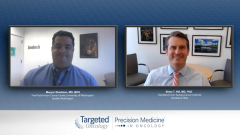
Bispecific Antibody Therapy R/R DLBCL
Two experts examine bispecific antibody treatment use for relapsed/refractory diffuse large B-cell lymphoma.
Episodes in this series

Mazyar Shadman, MD, MPH: A very important class of targeting agents that we’re watching closely at the meetings mainly, and we’ve had at least 1 major publication coming out, is the bispecific antibodies that target CD20 on the tumor and CD3 on the T cells. This would be another way of engaging T cells. With the CAR [chimeric antigen receptor] T-cell therapy, we take the T cells out, we modify them and put them back in the patient’s body, and then the T cells do the job. Here we basically bring the T cells to the lymphoma cells, and the responses are promising. In a way, this is a form of immunotherapy that unlike CAR T therapy lets patients stay most of the time with their original practice, without needing to travel to a major center. It’s an ongoing therapy in the form of either IV [intravenous], or some of these products are given subcutaneously. Some of these bispecific antibodies are time limited, but some of them are even until progression. It’s a very important class of drugs for lymphoma, with a potential future of basically being used as monotherapy for some kinds of lymphoma, and more importantly, large cell lymphoma, probably added to a chemotherapy backbone or some other novel agent. There’s a lot to be done and a lot of studies that are ongoing and will be done, but definitely bispecific antibodies are an important class.
Brian T. Hill, MD, PhD: I agree. One of the questions that comes up is can we foresee a time in the future when traditional chemotherapy could be completely avoided? And I don’t think that that’s likely in the near future for young, fit patients with diffuse large B-cell lymphoma [DLBCL]. We have such a long track record of success where we actually cure the majority of patients with DLBCL. But I do think that exploring immunotherapy earlier in lines of treatment, like with the more well-tolerated CAR T-cell therapies or with the bispecifics where, as you point out, you’re engaging the patient’s own T cells to redirect them toward the target tumor B cell. In those cases, it may be a good opportunity in the future for the older, frailer patient population who really can’t tolerate R-CHOP [rituximab, cyclophosphamide, doxorubicin, vincristine, prednisone], and such therapy would be considered unsafe. So far, what we can see with the tolerability of the bispecifics, there can be some fevers and a little bit of cytokine release syndrome, but generally they seem to be very well tolerated.
Mazyar Shadman, MD, MPH: Yes. It seems that for large cell lymphoma at least, they need to find a good partner. As monotherapy, they’re definitely effective and we’ve seen amazing responses. Just as a treatment regimen by itself, for large cell lymphoma at least, we’re looking at combination therapies.
Will we see a chemotherapy-free time for large cell lymphoma? I hope so. But as you said, 6 months of chemotherapy and a 60% to 70% cure rate is not a bad thing. Long-term toxicities from R-CHOP are not as bad as some other chemotherapy combinations. Remember it took us, what, 20 years maybe, if the press release holds, to find another regimen to beat R-CHOP. It would be a very difficult task to go with a chemotherapy-free regimen in the front line, but that’s definitely the ultimate goal, right, to provide the highest efficacy with limited or no toxicity. I don’t know how soon that will happen, but we’re hopeful.
Going back to targeting CD19 in the first-line setting, we did have a study, it was ZUMA-12, where patients received 2 cycles of chemotherapy, and they would get axi-cel [axicabtagene ciloleucel] if they didn’t have the optimal response to the first 2 lines. It’s being tested. We had also a study with bispecific antibodies in an elderly population in the front line with large cell lymphoma. Just the fact that those studies are happening means that the field is thinking about this chemotherapy-free approach.
We talked about bispecific antibodies. All or most of these are CD20 and CD3 targeting. We have BLINA, blinatumomab, which is an approved BiTE [bispecific T-cell engager] for ALL [acute lymphocytic leukemia], which targets CD19 on leukemia cells and CD3 on T cells. Of course, you’ve seen some studies….
Brian T. Hill, MD, PhD: It’s interesting that there’s so much renewed interest in this because there was a pretty decent sized study of blinatumomab in B-cell non-Hodgkin lymphoma published several years ago now, that showed pretty reasonable clinical activity. Of course, the medication must be given in the hospital because there is cytokine release syndrome, and it needs a continuous infusion, there’s potential risk for neurotoxicity. But in large part, it never made its way to regulatory approval, and it would be difficult to justify using it in an off-label setting. But there is experience using that. It was sort of proof of principal that you could use a bispecific T-cell engager, in this case that targets CD19. But the newer ones that are in development are mostly targeting CD20, which may have some limitations in the relapsed setting. We know, of course, that CD20 loss is a well-documented phenomenon after a rituximab-containing chemoimmunotherapy, and most of the studies of the anti-CD20 bispecific agents require a biopsy that shows CD20 expression. You’re already kind of limiting your pool of eligible patients to those who have CD20. In our practice, and I’m sure you’ve seen the same thing, where we’ve had patients who have had chemoimmunotherapy with R-CHOP, and they’ve had CAR T, and now we biopsy them, and they don’t have CD20 and they don’t have CD19. There’s still an area for development of new targets; clearly CD79b is a unique one that polatuzumab targets, but there are likely others out there.
This transcript has been edited for clarity.












































